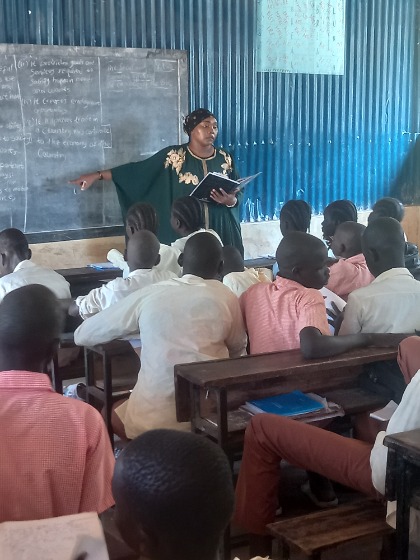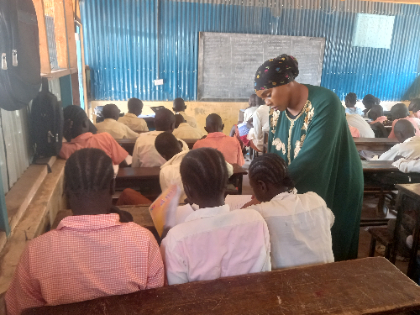What we do as teachers: Supporting mental health in refugee camp classrooms

Christine Mwongera
Trigger warning
Text includes reference to sensitive content including suicide.A motorbike’s tire burst near the school fence and the sound caused my students to panic, jumping and running out of the class. I stood there confused because I was certain it was just a tire burst. I didn’t realize that most of my class was associating the noise with the familiar and traumatic sound of a gunshot.
It makes me sad to know that many of my students don’t see school as a safe space where no one can harm them. I see how most will sit at the edge of their chairs and panic at the smallest mistake. When I asked why, they told me that it is because they are ready to run. It’s something they have done during most of their childhood and early teenage years.

As a teacher in Kakuma refugee camp, this type of response is not uncommon coming from students, but despite working here for the past five years, it is still not easy to hear. I have experienced firsthand the harmful effects that mental health has on children of all ages, which often comes in the form of stress, anxiety, and/or depression. Refugee and displaced youth are often extremely vulnerable to the common risk factors that can result in poor mental health outcomes such as child abuse, trauma or neglect, social disadvantage, poverty or debt, or discrimination.
When one sinks into depression or is unable to manage their emotions, it may result in unhappiness, violence, decreased enjoyment of life, social, domestic, and family conflict, social isolation, drug abuse, legal and financial problems, eating disorders, or the inability to keep up with schoolwork or maintain a job. Further, if mental health conditions go untreated, it may lead to more devastating consequences, especially for refugee and displaced youth navigating mental illness with limited support networks and resources.
Last year, towards the end of October, a student died by suicide in my school. He should have been promoted to the next class, but his mother found his lifeless body hanging from the roof of one of their rooms. The previous day, he had told his mother that he felt bad that she was struggling to take care of him and his siblings. He could not stand the poverty at home and also complained that COVID-19 had taken away his excitement to be in school. His mother had been persuading him to go back to school, but he said he had lost hope since his peers were two terms ahead of him and he felt left behind. This was the third student in my school to take away his life.
Beyond the school that I teach at, suicide is a devastating issue that affects our entire community. Before finishing this article, another student in a neighbouring primary school died by suicide. He no longer felt motivated to be in school and claimed to hate that he was a refugee. He was barely in his pre-teen years. In the beginning of this year, two men and a woman had taken their lives a kilometre away from the school. Another man, whose homestead was few minutes from our school, also died by suicide leaving behind eight children.
Almost one million people die due to suicide every year, and it is the third leading cause of death among young people. According to the World Health Organization, refugee and immigrants are among the most vulnerable groups for risk of suicide, especially for those who also identify as LGBTI. Suicide is a serious yet preventable public health issue. Despite the fact that it can often be avoided with simple and affordable solutions, right now, less than 40 countries around the world have a national suicide prevention strategy and even fewer treat suicide as one of their health priorities.
What do we do as teachers?
We try to solve some of these issues in every way we can with the help of the organizations available to support. We are not quiet about these issues.
Not only do teachers often lack the training and resources to provide appropriate psycho-social support to students, they themselves are often navigating their own mental health trauma. Incentive teachers from the local camp often carry their own traumatizing histories while most national teachers who come to work at the camp must cope with the stress of being so far away from their homes and families for prolonged periods of time.

When I realized why my students sat at the edge of their seats, I volunteered to attend several training sessions in guidance and counselling at the certificate level. With the help of the Japan Association for Aid and Relief (AAR Japan), we trained peer counselors to help the teacher counselors. Counselling sessions are done at every lunch break and follow-ups are done every late afternoon. We invited a nurse from the International Red Cross to talk to students about health issues, sexuality, and hygiene. We also asked students to choose a topic and invited FilmAid to air short films on the topics that students were interested in to make learning more enjoyable.
I also started a life-skills club that meets every Tuesday and Thursday to empower youth, especially the girls, on how to make a livelihood during their free time. With the training that World Vision provided to teachers on peacebuilding, a peace club was even started in our school.
We involve parents in solving these issues because I believe in the English saying that “charity begins at home”. We let the parents know if we see that the child is troubled or isolated so that they too can be involved in problem-solving. We also refer students to Jesuit Refugee Services, an organization that offers psychosocial support to everyone in the camp.
My final reflection on this is that there are some identified gaps in offering psychosocial support. Data is a huge problem. Though I have seen up close how untreated mental illness has terrorized my classroom, it is very difficult to find information and data about how mental illness is affecting young refugee and displaced populations and at what rate. Another gap is the lack of organizations that provide mental health and psychosocial support; in Kakuma refugee camp, for example, we only have one. Also, governments are not employing enough (and in some cases, any) mental health professionals that can assist educators.
To support teachers, there must be comprehensive training on psychosocial issues and how to deal with children’s mental health, as well as training on how to provide counseling both in-person or on the phone. Additionally, there must be more extracurricular activities that support children in overcoming their trauma, especially in communities that host refugee and displaced youth. Finally, there must be more policies put in place, informed by stakeholders and students, to reduce the factors that contribute to poor mental health outcomes and to incentivize teachers to take these programs.
- Date modified: